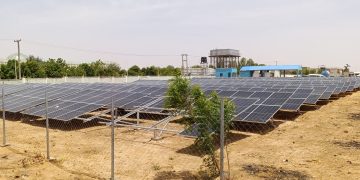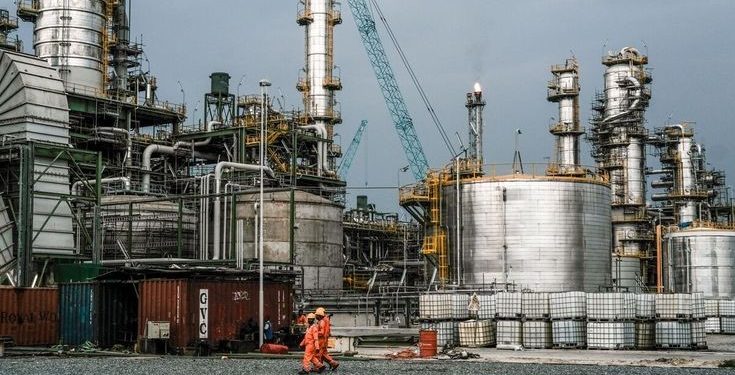Nigeria’s crude oil export receipts fell by ₦3.18 trillion in the first half of 2025, a sharp deterioration that highlights the twin challenges of domestic production volatility and weakening global demand dynamics. While local output issues remain central, several market analysts and trade observers say that a major factor dampening prices and export values this year has been the ripple effects of the United States’ expanded tariff regime, frequently dubbed “Trump tariffs,” which has slowed trade growth and clouded oil demand prospects worldwide.
What the numbers show
Data from the National Bureau of Statistics and reporting by local media indicate that crude export earnings slipped from ₦28.10 trillion in H1 2024 to ₦24.92 trillion in H1 2025, an 11.3% year-on-year decline that translates to the ₦3.18 trillion shortfall. The fall came even as some on-field production metrics showed mixed signals, underscoring that price and demand movements, not only volumes, drove much of the value loss.
How U.S. tariffs entered the equation
Beginning in early 2025 the U.S. enacted a wide set of tariffs and trade measures affecting dozens of trading partners and a swathe of goods. Analysts warn this policy shift has the potential to slow global economic growth and crimp commodity demand. Major commodities forecasters and market intelligence houses argued that the tariff shock has already lowered oil demand growth forecasts for 2025 and beyond, pressuring prices and reducing the revenue Nigeria can extract for each barrel. In July, Reuters and other market watchers explicitly linked downward pressure on oil prices to investor concern over the tariffs’ demand impact.
Energy consultancies have modeled the effect. Tariff-induced slower GDP growth reduces transport and industrial fuel demand, which in scenario analysis can shave hundreds of thousands of barrels per day off expected demand growth. That is enough to move price forecasts materially and depress export receipts for producers reliant on headline prices. This indirect but powerful transmission mechanism is a key reason why commentators single out tariff policy as a major driver alongside the usual supply-side factors.
Domestic factors: output and product mix
While tariffs and weakening global demand played a meaningful role, domestic production issues amplified the pain. Nigeria’s oil sector continues to grapple with pipeline vandalism, operational downtimes, field maintenance backlogs and contractual disputes that periodically interrupt deliveries and lower quality or realized prices for some grades. At the same time, the composition of Nigerian exports is shifting. Non-crude exports expanded in H1 2025, partly cushioning the external account even as crude receipts fell. These structural dynamics mean that a blunt price shock externally can rapidly translate into a fiscal headache at home.
Fiscal and FX consequences
Crude oil remains a large component of Nigeria’s foreign exchange inflows and government revenue. The ₦3.18 trillion decline in crude receipts in H1 2025 therefore raises fiscal pressures, larger budget deficits, tougher choices on capital projects, and potential short-term recourse to borrowing. Lower dollar inflows also increase risk to the naira, especially if capital flight or import needs rise in a slowing global trade environment. Policymakers face a narrow window to shore up buffers and accelerate non-oil revenue mobilization.
Market reaction and short-term outlook
Oil markets have shown sensitivity to tariff headlines. On days when U.S. tariff rhetoric intensified, global crude benchmarks fell as traders discounted weaker forward demand. Conversely, geopolitical shocks such as disruptions to Russian flows have on occasion pushed prices up, producing a seesaw that keeps Nigerian receipts volatile. In the near term, sustained tariff-led demand losses would keep downward pressure on prices. Only a clear recovery in global growth expectations or coordinated production cuts by exporters would lift nets significantly for Nigeria.
What to watch next
Developments around U.S. tariffs remain critical, especially any escalation, rollback, or carve-outs that change global trade momentum. OPEC+ production decisions could either offset or amplify weaker demand. Nigeria’s own production trajectory will be decisive, particularly whether output stabilizes and losses from theft and vandalism are curbed. Another key factor is the performance of non-oil exports, which, if sustained, can reduce the country’s vulnerability to oil market shocks.
The ₦3.18 trillion fall in crude export receipts in H1 2025 is not the result of a single cause. It sits at the intersection of domestic production fragilities and an increasingly fragile global demand picture, a picture materially influenced by U.S. tariff policy that has knocked down growth and oil demand forecasts. For Nigeria, the episode is a timely reminder that fiscal resilience requires diversifying export earnings, fixing upstream risks, and preparing for external shocks that can arrive not only from the energy complex but also from trade policy decisions half a world away.
























































